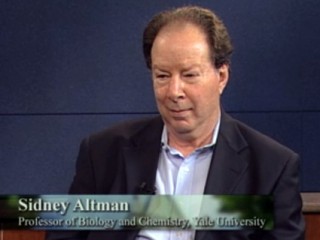
Sidney Altman biography
Date of birth : 1939-05-07
Date of death : -
Birthplace : Montreal, Quebec, Canada
Nationality : Canadian
Category : Science and Technology
Last modified : 2011-09-20
Credited as : biochemist and biologist, Nobel Prize for Chemistry, ribonucleic acid RNA
0 votes so far
Molecular biologist Sidney Altman discovered in 1983 that ribonucleic acid (RNA) can initiate some biological reactions, acting as a abiocatalyst and seemingly playing the role of a protein enzyme. This overturned the established scientific understanding that RNA acts only as a carrier of genetic information, and challenged basic biological tenets on the origins of life. He won the Nobel Prize for Chemistry in 1989, sharing the award with Thomas R. Cech, who reached very similar conclusions in his own independent work.
Altman's discovery of catalytic RNA has shaken the very foundations of the biosciences, altering their central principle. Even more significantly, it has had a profound impact on our understanding of how life on earth began and developed. Scientists have known that the flow of genetic information from DNA to protein requires enzymes and other proteins. Altman's discovery has gone a long way toward answering one of the most puzzling questions confronting bioscientists who have long sought to determine which was the first biomolecule-DNA or protein? In light of Altman's research, it now appears that RNA molecules were the first biomolecules to contain both the genetic information and play a role as biocatalysts. His discovery of catalytic RNA has also given gene technology researchers a new tool with the potential for creating a new defense against infection. In 1997 Altman himself experimented with a method to combat bacteria's resistance to antibiotics by inserting artificial genes in bacteria to make them more sensitive to ampicillin and chloramphenicol, two widely used antibiotics.
In 1984 Altman, who was now chairman of Yale's biology department, became a naturalized American citizen, although he retained his Canadian citizenship. A year later he was named dean of Yale College, a post in which he served for the next four years. As dean, he helped to win an expanded role for science education in all of Yale's curricula. The crowning glory of Altman's career in scientific research came in 1989 when he and Thomas Cech were jointly awarded the Nobel Prize in Chemistry for their independent studies demonstrating the catalytic ability of RNA. It is hard to overestimate the importance of their discovery, which proved conclusively that nucleic acids were the building blocks of life, acting as both genetic codes and enzymes. According to Notable Scientists: From 1900 to the Present, in presenting the award to Altman and Cech, the Nobel Academy described their discovery as one of "the two most important and outstanding discoveries in the biological sciences in the past 40 years," the other being the discovery by Crick and James D. Watson of DNA's double-helix structure. The findings of Altman and Cech about the catalytic properties of RNA have provided geneticists with a strong foundation for research into possible medical applications. It seems reasonable to believe that if RNA enzymes can cut additional sequences of tRNA from a strand of precursor tRNA, medical professionals could possibly use RNA enzymes to cut infectious RNA from the genetic system of someone infected with a viral disease.
A member of the National Academy of Sciences, the American Society of Biological Chemists, and the Genetics Society of America, Altman also received the Rosenstiel Award for Basic Biomedical Research in 1989. In 1991 he was selected to present the DeVane lecture series at Yale on the topic "Understanding Life in the Laboratory." In a 1997 address to incoming freshmen, posted on Yale University's Web site, Yale President Richard C. Levin offered this quote from Altman on the joys of discovery: "When I was a post-doc, I did an experiment that resolved a problem that I had been working on for a year or more. When I saw the result, there was not only the feeling of relief you get when you stop banging your head against a wall, but, more important, I then understood some of the puzzling results that had been published by others in the years before. The feeling of great satisfaction at having solved my problem as well as having illuminated others kept me floating on air for weeks."
Awards and honors:
Nobel Prize for Chemistry 1989 (with Thomas R. Cech)
Lewis S. Rosenstiel Award for Distinguished Work in Basic Medical Science 1989
National Institutes of Health Merit Award 1989
Novartis-Drew Award in Biomedical Research 1999
Biomega Laboratories Scientific Advisory Board
Chiron Corporation Scientific Advisory Board, PathoGenesis Corp.
Antisense and Nucleic Acid Drug Development Editorial Board (1997-)
American Scientist Editorial Board (1977-90)
Cell Associate Editor (1983-87)
RNA Editorial Board (1995-)
American Academy of Arts and Sciences 1990
American Association for the Advancement of Science 1987
American Philosophical Society 1990
American Society for Biochemistry and Molecular Biology
Council on Foreign Relations
Damon Runyon Cancer Research Foundation Research grant, 1967-69
Damon Runyon Cancer Research Foundation Board of Directors
Dibner Institute for the History of Science and Technology Trustee (2000-)
Federation of American Scientists Board of Sponsors
Genetics Society of America
National Academy of Sciences 1990
Weizmann Institute of Science Board of Governors
















